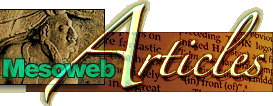

| Note: If you arrived at this page via Mesoweb Search, use your browser's Find feature to locate the text of interest, then click the link to go to the illustrated page. Or click here to go to the beginning of the article. |
|
Go to page: Acanceh's main Precolumbian building sits right at the northern edge of the modern town's main square, perfectly integrated with the street grid and a context of contemporary shops and businesses. Far from being a mummified remain of the past, this structure is still very much an active participant in the town's communal life, as can be attested by the foliage that covers its southern façade in this photograph and which was laid there by an enthusiastic populace celebrating the Catholic festivity of Palm Sunday.
Go to page: Recent investigations at Acanceh's main building yielded the discovery of four huge architectural stucco masks. Some of the iconography that can still be made out on these masks may hark back to Olmec times (1500-500 B.C.). Notice in this particular example the three-element headband around the forehead, as well as the merlon-shaped insets above the mask's eyes. The three-element headband (which some scholars take to be a representation of sprouting corn) is thought to have given way to the so-called Jester God headdress in Classic Maya imagery, in which a deity that symbolizes rulership wears a three-pointed, jester-like cap. Go to page: Their style, the stratigraphic data and the general character of the building phase they are associated with seem to chronologically place these masks sometime in the very Early Classic period (ca. 200-300 A.D.) or possibly even the Late Preclassic (or some two-thousand years before the present). The "L" shape of this example's eyes is strongly reminiscent of Olmec masks and is absent in Classic Maya imagery, which argues for the masks harking back to the Preclassic. Notice here, also, the three-element headband the mask is wearing. Go to page: Although Maler reported remains of masks and other stucco decorations on this building, the remains he saw are long gone. Discovery at Acanceh's main building of this and three other large masks was carried out only in the course of very recent excavation work. This particular example is well preserved only in the earflares. These display most of the elements found in representations of architectural masks elsewhere in the Maya area, to wit: the knots under and above the earflare proper and the foliation that seems to grow from the upper portion of the earflare. The destroyed elements in this mask, modelled in painted stucco, reveal the stone armature over which the stucco was applied. Go to page: This is the worst-preserved mask of the four that have come to light so far at Acanceh's main building. Its right earflare is mostly intact though, and it displays the same elements as the one just mentioned. Also in evidence are eyes with spirals in them, which would place them more in line with Classic Maya deity imagery than the L-shaped eyes displayed in at least one other example of the architectural masks from this building. Other Maya sites with early stucco masks comparable to these include La Laguna Chakanbakan, Kohunlich, Becan and Edzna. Go to page: Northeast of the main pyramid at Acanceh, recent archaeological work conducted by Beatriz Quintal's team uncovered this important building, probably harking back originally to the Early Classic period. Until recently, only the main pyramid and the palace of the stuccos were ever mentioned when speaking about Acanceh's ancient past, but Quintal's excavations and survey work have made it clear that this town once covered a large area and was prosperous and important enough to have built major civic and religious structures. Go to page: Until recently little more than a large undulating, shapeless mound, the so-called Palace of the Stuccos has been carefully cleaned and consolidated, revealing a complex structure that includes many once-vaulted rooms and stairways. Its non-pyramidal nature would probably point to its inclusion in the broad category of palaces or range-type structures which, modern scholars speculate, may have once functioned as administrative buildings and/or as the dwelling places of the ruling class and other high-status individuals. Go to page: Detail of the elaborate stucco frieze that gives the Palace of the Stuccos its modern sobriquet. All kinds of (probably mythological) beasts are shown in various poses, each sitting inside a double-frame strongly reminiscent of the shapes modern iconographers have come to identify by the Maya word ohl. These "ohl" shapes, in their full form, were conventionally depicted as squarish enclosures with inset corners. The shape itself and very possibly its associated meaning, hark back to Olmec times. "Ohl" were conceived of as portals or passages which trained specialists (not unlike medicine men), perhaps with the aid of fasting, hallucinogens and other techniques for inducing altered states of consciousness, could use to ensure passage into the realm of the supernatural. Go to page: The motif of framed mythological beings continues on this portion of the stucco frieze. Between two of these frames sits a glyph reminiscent of the one used for writing puh, which modern epigraphers take to be a mention of the mythological Place of Cattail Reeds and, by extension, of the distant, mighty Teotihuacan. On the uppermost portion of the frieze, the endless repetition of what appears to be a glyph for the syllable le, commonly associated with water, lends strength to the argument that this frieze recounts some passage from Maya mythology, as many such scenes elsewhere are marked by similar le glyphs, which served to place depicted events as happening in a watery place (i.e., the supernatural realm). |